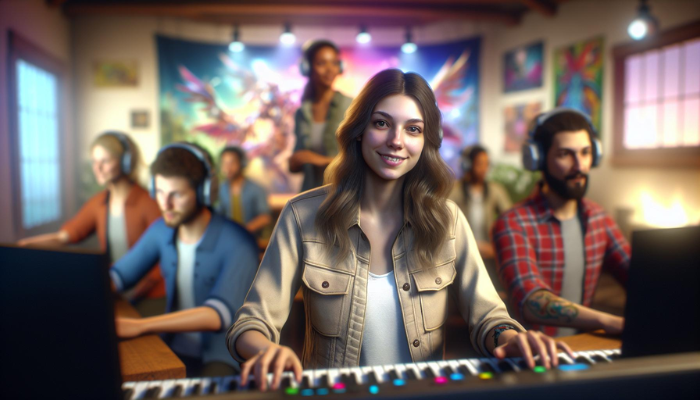
Harmonicode is an innovative concept that seamlessly blends the worlds of music and coding. By integrating programming with harmonic structures, it creates a new way to compose, analyze, and visualize music through code. Whether you’re a musician looking to explore algorithmic compositions or a developer interested in creative coding, harmonicode offers a groundbreaking intersection of art and technology. In this article, we’ll explore the essence of harmonicode, its practical applications, benefits, and the future it holds.
What is Harmonicode? Understanding the Concept
Harmonicode is a fusion of “harmony” and “code,” referring to the practice of using programming languages to generate, manipulate, and analyze musical compositions. This concept allows for algorithmic composition, dynamic soundscapes, and interactive musical experiences that go beyond traditional notation and performance methods.
By leveraging programming languages such as Python, JavaScript, and Sonic Pi, harmonicode enables musicians and developers to create intricate melodies and harmonies through scripted instructions. This approach enhances the precision and flexibility of music production, offering a new way to experiment with sound generation.
Additionally, harmonicode fosters a deeper understanding of music theory by visualizing harmonic relationships through code. Developers can program chord progressions, simulate orchestration, and even create generative music that adapts to user input. This makes it a valuable tool for both seasoned musicians and coding enthusiasts.
Applications of Harmonicode in Music and Technology
Harmonicode has a wide range of applications in both music composition and technological innovation. It is increasingly used in music production software, interactive installations, video game soundtracks, and artificial intelligence-driven music generation.
One major application is live coding, where musicians write and modify code in real-time to produce evolving musical pieces. Platforms like TidalCycles and Sonic Pi allow performers to improvise electronic music by altering code on the fly. This creates an engaging and ever-changing auditory experience for audiences.
Another application is in AI-generated compositions, where machine learning algorithms analyze patterns in harmonicode-generated music to create entirely new pieces. Companies developing AI music assistants leverage harmonicode principles to refine their models, ensuring compositions sound natural and aesthetically pleasing.
Benefits of Learning and Using Harmonicode
One of the biggest advantages of harmonicode is its ability to democratize music production. Traditional composition methods require years of training, but with harmonicode, anyone with coding knowledge can generate complex musical structures with ease.
Another key benefit is automation and efficiency. Composers can use algorithms to create endless variations of melodies and harmonies, saving time while exploring creative possibilities. Harmonicode also helps in sound synthesis, allowing developers to experiment with custom instrument tones and textures using simple code snippets.
Moreover, harmonicode enhances interdisciplinary learning. By merging music and programming, it fosters a unique skill set that is valuable in both creative and technical fields. This synergy opens doors to careers in digital music production, game design, and AI-generated art.
How to Get Started with Harmonicode: A Beginner’s Guide

Getting started with harmonicode doesn’t require extensive musical training or coding expertise. Beginners can start by exploring open-source platforms like Sonic Pi, which provides an intuitive way to write musical code.
First, familiarize yourself with basic music theory concepts such as notes, scales, and chord progressions. Then, choose a coding language that supports musical programming, such as Python (using libraries like Pyo or FoxDot) or JavaScript (using the Tone.js framework).
Once you have a grasp of the basics, experiment with writing small code snippets that generate simple melodies. Gradually, you can explore more advanced techniques such as algorithmic improvisation, sound synthesis, and live coding performances. Online communities, tutorials, and coding challenges can also accelerate your learning process.
The Future of Harmonicode: Innovations and Trends
As technology continues to evolve, harmonicode is expected to play a crucial role in shaping the future of music. AI-driven music composition, blockchain-based music ownership, and virtual reality soundscapes are just a few emerging trends influenced by harmonicode principles.
One exciting development is the use of generative music in adaptive environments, where sound dynamically changes based on user interaction. This is particularly relevant in gaming and virtual reality applications, where harmonicode-generated soundtracks can react to player movements in real-time.
Moreover, as more educational institutions integrate coding into their curriculums, harmonicode could become a standard learning tool for students interested in both music and programming. With increasing accessibility and community support, harmonicode has the potential to revolutionize how we create, experience, and interact with music.
Conclusion
Harmonicode represents a powerful convergence of music and technology, offering limitless possibilities for creative expression. Whether you’re a musician looking to explore new compositional techniques or a programmer eager to dive into audio development, harmonicode provides an exciting playground for innovation. As the field grows, it will continue to shape the future of music production, live performance, and interactive media.
FAQs About Harmonicode
1. What is harmonicode used for?
Harmonicode is used for algorithmic music composition, live coding performances, AI-driven music generation, and interactive sound design in games and media.
2. Can I use harmonicode without prior coding experience?
Yes! Platforms like Sonic Pi offer beginner-friendly ways to experiment with musical coding without needing deep programming knowledge.
3. Which programming languages support harmonicode?
Languages like Python, JavaScript, and specialized music coding languages like TidalCycles and SuperCollider support harmonicode applications.
4. How does harmonicode benefit musicians?
It enables musicians to create complex compositions programmatically, explore algorithmic music, and automate aspects of sound design and production.
5. What software tools are best for harmonicode?
Popular tools include Sonic Pi, TidalCycles, FoxDot, and Tone.js, all of which facilitate coding-driven music creation.
6. Is harmonicode only for electronic music?
No, harmonicode can be applied to various genres, from classical compositions to experimental and ambient soundscapes.
7. Can harmonicode be used for live performances?
Yes, live coding performances using harmonicode are increasingly popular in electronic music and interactive art installations.
8. Are there online communities for harmonicode enthusiasts?
Yes, platforms like GitHub, Discord, and various forums have active communities sharing projects and techniques.
9. How does AI interact with harmonicode?
AI can analyze harmonicode-generated music to create new compositions, optimize musical arrangements, and generate real-time adaptive soundtracks.
10. What is the future of harmonicode?
Harmonicode is expected to expand into virtual reality, AI-generated music, and blockchain-based creative ownership models, transforming digital music creation.





